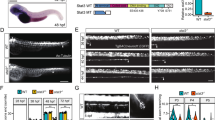Abstract
Caffeine affects early in vivo murine brain development by accelerating the evagination of the primitive neuroepithelium into telencephalic vesicles. In this model, caffeine induces the expression of the regulatory subunit α of protein kinase A (PKA RI α) and of Sonic hedgehog (Shh). The understanding of the molecular mechanisms linking caffeine and neural gene expression would benefit from a reproducible in vitro model. Accordingly, the present study aimed to determine whether caffeine modulated the expression of these genes in primary neuronal and astroglial cultures derived from developing murine neocortex. Using real-time PCR, the results showed that caffeine induced robust overexpression of Shh mRNA in both cell types without significantly modifying PKA RI α gene expression.
Similar content being viewed by others
References
Brenneman D. E., Phillips T. M., Festoff B. W., and Gozes I. (1997) Identity of neurotrophic molecules released from astroglia by vasoactive intestinal peptide. Ann. N. Y. Acad. Sci. 814, 167–173.
de Lima A. D., Merten M. D., and Voigt T. (1997) Neuritic differentiation and synaptogenesis in serum-free neuronal cultures of the rat cerebral cortex. J. Comp. Neurol. 382, 230–246.
Echelard Y., Epstein D. J., St-Jacques B., Shen L., Mohler J., McMahon J. A., and McMahon A. P. (1993) Sonic hedgehog, a member of a family of putative signaling molecules, is implicated in the regulation of CNS polarity. Cell 75, 1417–1430.
Epstein D. J., Marti E., Scott M. P., and McMahon A.P. (1996) Antagonizing cAMP-dependent protein kinase A in the dorsal CNS activates a conserved Sonic hedgehog signaling pathway. Development 122, 2885–2894.
Ericson J., Morton S., Kawakami A., Roelink H., and Jessell T. M. (1996) Two critical periods of Sonic Hedgehog signaling required for the specification of motor neuron identity. Cell 87, 661–673.
Ho K. S. and Scott M. P. (2002) Sonic hedgehog in the nervous system: functions, modifications and mechanisms. Curr. Opin. Neurobiol. 12, 57–63.
Hynes M., Porter J. A., Chiang C., Chang D., Tessier-Lavigne M., Beachy P. A., and Rosenthal A. (1995) Induction of midbrain dopaminergic neurons by Sonic hedgehog. Neuron 15, 35–44.
Kimmel C. A., Kimmel G. L., White C. G., Grafton T. F., Young J. F., and Nelson C.J. (1984) Blood flow changes and conceptal development in pregnant rats in response to caffeine. Fundam. Appl. Toxicol. 4, 240–247.
Marret S., Gressens P., Van-Maele-Fabry G., Picard J., and Evrard P. (1997) Caffeine-induced disturbances of early neurogenesis in whole mouse embryo cultures. Brain Res. 773, 213–216.
Nehlig A. and Debry G. (1994) Potential teratogenic and neurodevelopmental consequences of coffee and caffeine exposure: a review on human and animal data. Neurotoxicol. Teratol. 16, 531–543.
Pfaffl M. W. (2001) A new mathematical model for relative quantification in real-time RT-PCR. Nucleic Acids Res. 29, e45.
Prasad K. N., Hovland A. R., Cole W. C., Prasad K. C., Nahreini P., Edwards-Prasad J., and Andreatta C. P. (2000) Multiple antioxidants in the prevention and treatment of Alzheimer disease: analysis of biologic rationale. Clin. Neuropharmacol. 23, 2–13.
Ribeiro J. A., Sebastiao A. M., and de Mendonca A. (2002) Adenosine receptors in the nervous system: pathophysiological implications. Prog. Neurobiol. 68, 377–392.
Sahir N., Bahi N., Evrard P., and Gressens P. (2000) Caffeine induces in vivo premature appearance of telencephalic vesicles. Brain Res. Dev. Brain Res. 121, 213–217.
Sahir N., Mas C., Bourgeois F., Simonneau M., Evrard P., and Gressens P. (2001) Caffeine-induced telencephalic vesicle evagination in early post-implantation mouse embryos involves cAMP-dependent protein kinase (PKA) inhibition. Cereb. Cortex 11, 343–349.
Stewart G. A., Lowrey J. A. Wakelin S. J., Fitch P. M., Lindey S., Dallman M. J., et al. (2002) Sonic hedgehog signaling modulates activation of and cytokine production by human peripheral CD4(+) T cells. J. Immunol. 169, 5451–5457.
Watkinson B. and Fried P. A. (1985) Maternal caffeine use before, during and after pregnancy and effects upon offspring. Neurobehav. Toxicol. 7, 9–17.
Author information
Authors and Affiliations
Corresponding author
Rights and permissions
About this article
Cite this article
Sahir, N., Evrard, P. & Gressens, P. Caffeine induces sonic hedgehog gene expression in cultured astrocytes and neurons. J Mol Neurosci 24, 201–205 (2004). https://doi.org/10.1385/JMN:24:2:201
Received:
Accepted:
Issue Date:
DOI: https://doi.org/10.1385/JMN:24:2:201




